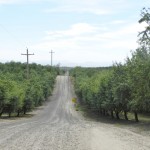
In California, the dream of endless riches that started with the gold rush has never stopped resonating— nor has the inevitable disappointment when the dream turns to a nightmare.
The latest rush is occurring right here in the San Joaquin Valley, where money really does grow on trees. A boom in almond and pistachio prices has resulted in what may yet be another harrowing bust in California’s long history of economic downturns following spectacular rises.
Speculation in almonds and pistachios has driven farmland prices sky high. Since 2008, 100,000 acres have been added in farmland for nuts, much of it in Stanislaus and Merced counties. Farmland for nuts is now valued more highly than any other commodity and sells in some places for $18,000 to $20,000 per acre. Just recently in Merced County, 1200 acres without a reliable source of water sold for $15,000 an acre.
Farming these days is less and less the province of the family farmer and more and more the big business of high-end investors and speculators. Out in eastern Stanislaus County, ranches formerly held for generations by cattlemen and dry land farmers are being gobbled up and converted to orchards at astonishing rates.
No sooner is the land purchased than the planting begins. State-of-the-art pumps and irrigation systems are fed by wells drilled hundreds of feet deep. Modern harvesting technology enables the new nut growers to plant on hillsides. Some of the orchards in eastern Stanislaus County extend over the rolling foothills almost to the edge of the oak woodland that marks the steep ascent into the Sierras.
In the 1980s, farmers were pleased with 1400 pounds of almonds an acre. The average yield in 2011 was 2670 pounds per acre. That’s just the average. Today, during the boom in eastern Stanislaus and Merced Counties, people are talking about yields up to 4000 pounds per acre. While some of the talk may be hyperbole, there’s no question almond yields are at an all-time high.
California’s universities, especially the University of California at Davis, have pioneered agricultural research that increases profits and reduces overhead. Today’s trees are planted closer together—fourteen feet apart instead of twenty-two or twenty-four. They receive water and fertilizer directly to their root systems via the precise delivery of drip irrigation. Twenty-five years ago, an almond orchard needed five to seven years to achieve profitability. Today, some orchards are delivering profits after only four years in the ground.
The profits can be astounding. The University California Cooperative Extension estimates net profits above total costs at $1453 an acre when almonds are selling at $2.10 a pound. That’s assuming the average yield of 2600 pounds of nuts per acre. Some players in today’s bull market are claiming far higher profits—as much as $3000 an acre.
If the numbers and land rush seem eerily familiar, they should. Given recent history in both the stock market and real estate industry, one would expect yellow caution flags to be waving frantically around the farm land marketplace, but that’s not the case. Farmland keeps selling and prices keep rising.
As with any California boom, history is forgotten. Otherwise, the history of almond prices would suggest caution on the part of speculators and California dreamers. While almond prices in the last few years have been rising, the laws of supply and demand suggest that sooner or later there will be an almond glut. And prices of almonds have always fluctuated erratically.
In 1999, almonds dropped to a heart-stopping 87 cents a pound and by the 2000-2001 market were up to only $1.01 a pound. At least one almond trader had his hair turn gray over a seven month span, when he was losing money at a clip of $50,000 a week. Given what buyers are paying for farmland, it will take years of rising prices to recoup their investments.
And then there’s water. Most of the nut orchards in eastern Stanislaus County are tapping an ever-diminishing aquifer. No one with experience in the ups and downs of farming expects prices to rise forever, and fewer still think the aquifer will last even through the twenty-five year cycle of an almond orchard.
Just as with previous California booms, the nut boom seems destined to go bust, perhaps much sooner than even the pessimists think. And that’s when the speculators will realize investing so recklessly in nuts, like wild investments everywhere, is just plain nuts.
